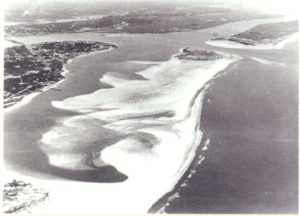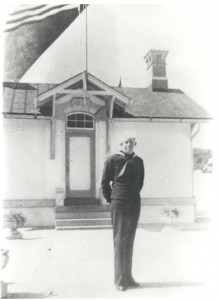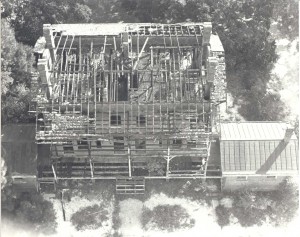This seventh installment in our ongoing series on the history of the St. Augustine Lighthouse focuses on the end of the lighthouse keepers at the lighthouse and environmental changes in the area.
Click the links below to read previous posts in the series:
- Lighthouse History Pre-1874
- Lighthouse History 1874-1894 (Part I)
- Lighthouse History 1874-1894 (Part II)
- Lighthouse History 1894-1914
- Lighthouse History 1914-1934
- Lighthouse History 1934-1954
1954 – 1974
Lighthouse keepers served a vital function, keeping lighthouses operational at all hours of the night for ocean-going mariners. Their responsibilities were many, including carrying oil to the lantern through the night, rewinding the clockwork mechanism that turned the Fresnel lens, and keeping everything polished and oiled for efficient operation. However, improved technology slowly eliminated these responsibilities and in 1955, after alterations made the lighthouse fully automated, they removed the lighthouse keeper positions from the St. Augustine Lighthouse.
Retiring in July of 1955, James Pippin was the last head lighthouse keeper at the St. Augustine Lighthouse. Following the abolishment of the lighthouse keeper positions, the U.S. Coast Guard appointed a single lamplighter whose responsibilities only required daily visits to the lighthouse. During these calls, the lamplighter would ensure that the light, lens, and motors were in good working order for the next evening. The first lamplighter was retired lighthouse keeper David Swain, who during his previous career served as 1st Assistant Keeper at the St. Augustine Lighthouse from 1933 to 1944.
While these operational and personnel changes occurred at the lighthouse, natural and artificial forces conspired to alter the area’s maritime landscape. The natural erosion and movement of sands along the St. Augustine coast was threatening to make the St. Augustine Inlet unnavigable. In the 1940s, the Army Corps of Engineers cut a new inlet to the north of the old one, essentially surrendering the later to its fate.

The formation of Conch Island as the old inlet filled in, 1953; courtesy of St. Augustine Historical Society
Natural forces continued to fill in the old inlet when Hurricane Dora struck St. Augustine directly in 1964. Dora’s churning offshore deposited sand in the area and brought together several small sand dunes that were beginning to surface in the area of the old inlet. These small sand dunes eventually merged into a formation called Conch Island. This growing island merged with the rest of Anastasia Island and completely closed the old inlet.
Lamplighter David Swain served until 1968 and his replacement, another retired “Coastie” named Henry “Hank” Mears, was the last lamplighter to serve at the lighthouse. During his career, Mears spent time in the region keeping the Cape Canaveral Lighthouse operating. While the lighthouse continued to serve the local maritime traffic, the Keepers’ House sat uninhabited after a few years as a rental property. In 1970, an early morning fire ripped through the almost 100-year-old structure, its cause unknown to this day.
The fire severely damaged the wood structure of the house though the brick walls, chimneys, and basement survived the fire intact. The following year, the kerosene oil house and another onsite storage house constructed in the 1880s were removed. The only evidence of their existence today is two sidewalks that simply end in the courtyard grass on either side of the tower’s entrance.
St. Johns County purchased the burned out house and entertained several different plans for the building. Despite the purchase, the structure remained damaged and uninhabited for about ten years, before a local group stepped in and took on the daunting restoration project.
LEARN ABOUT THE RESTORATION IN THE NEXT INSTALLMENT OF OUR LIGHTHOUSE HISTORY →
The view from the top of the tower is very different from the one keepers had for most of the lighthouse’s history. Come by and compare the past to the present!
Paul Zielinski is Director of Interpretation for the St. Augustine Lighthouse & Museum. He received his master’s degree in Public History from the University of West Florida and joined the lighthouse family in 2011.



